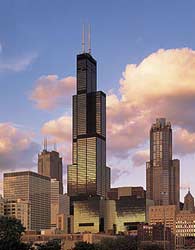Sears Tower to lose its name
14 Mar 2009
The 110-story Sears Tower, tallest office building in the Western Hemisphere, will be renamed the Willis Tower, global insurance broker Willis Group Holdings said on Thursday. Although Sears' naming rights had expired in 2003, it continued to be called the "Sears Tower" till now.
 The renaming is part of a deal with the London-based Willis Group Holdings. Along with moving 500 employees into 140,000 square feet on multiple floors of the 110-story building this summer, the Willis Group gets the naming rights as part of its lease agreement with the real estate investment group that owns Sears Tower.
The renaming is part of a deal with the London-based Willis Group Holdings. Along with moving 500 employees into 140,000 square feet on multiple floors of the 110-story building this summer, the Willis Group gets the naming rights as part of its lease agreement with the real estate investment group that owns Sears Tower.
"We certainly appreciate and understand the sentimental attraction to the Sears Tower name, and it's certainly a Chicago icon," said Will Thoretz, a spokesman in New York for Willis Holdings Group. "Our move into Chicago is a good thing for the city. We're bringing hundreds of jobs into the city."
Sears, once the largest US retailer, occupied what was then the world's tallest building as its headquarters after the skyscraper was completed in 1973. But it moved out in the early 1990s. Over the years the company lost ground to discounters like Wal-Mart Stores Inc in the clothing business and big-box hardware retailers like Home Depot Inc. Today's Sears Holdings Corp is controlled by billionaire financier Edward Lampert.
The name change isn't the first in recent years for Chicago. In 2006, the city's State Street shopping district saw Marshall Field's department store become Macy's and in 2003 the White Sox started playing baseball at US Cellular Field instead of Comiskey Park.
The Council on Tall Buildings and Urban Habitat lists the steel and glass tower as the fifth tallest completed building in the world. The tallest, at 1,670 feet, is the Taipei 101 building in Taiwan's capital.
Willis Group Holdings refers to itself as a global insurance broker "developing and delivering professional insurance, reinsurance, risk management, financial, and human resource consulting and actuarial services." It says it has more than 400 offices in nearly 120 countries.
In 1969, Sears, Roebuck & Co. was the largest retailer in the world, with about 350,000 employees. Sears executives decided to consolidate the thousands of employees in offices distributed throughout the Chicago area into one building.
As Sears continued to offer optimistic projections for growth, the tower's proposed height soared into the low hundreds of floors and surpassed the height of New York's unfinished World Trade Center to become the world's tallest building. Restricted in height not by physical limitation or imagination but rather by a limit imposed by the Federal Aviation Administration to protect air traffic, the Sears Tower would be financed completely out of Sears' deep pockets and topped with two antennas to permit local television and radio broadcasts.
Sears and the City of Chicago approved the design, and the first steel was put in place in April 1971. The structure was completed in May 1973. Construction costs totalled approximately $150 million at the time, which would be equivalent to roughly $950 million in 2005. For comparison, Taipei's Taipei 101, built in 2004, cost around the equivalent of $1.64 billion in 2005 dollars.
However, Sears' optimistic growth projections never came to pass. In 1994 Sears sold the building to Boston-based AEW Capital Management with financing from MetLife. At the time it was one third vacant. By 1995 Sears had completely vacated the building, moving to a new office campus in Hoffman Estates, Illinois.
In 1997 Toronto-based TrizecHahn Corp (the owner at the time of the CN Tower) purchased the building for $110 million, and assumption of $4 million in liabilities, and a $734-million mortgage. In 2003 Trizec surrendered the building to lender MetLife.
In 2004 Metlife sold it to a group of investors that includes New York investors Joseph Chetrit, Joseph Moinian, Lloyd Goldman, Joseph Cayre and Jeffrey Feil and Skokie-based American Landmark Properties. The quoted price was $840 million with $825 million held in a mortgage.






















